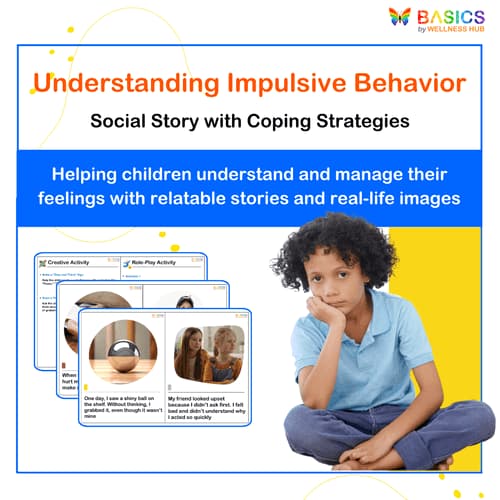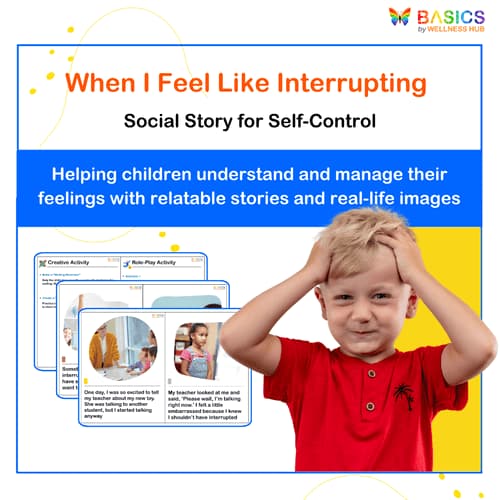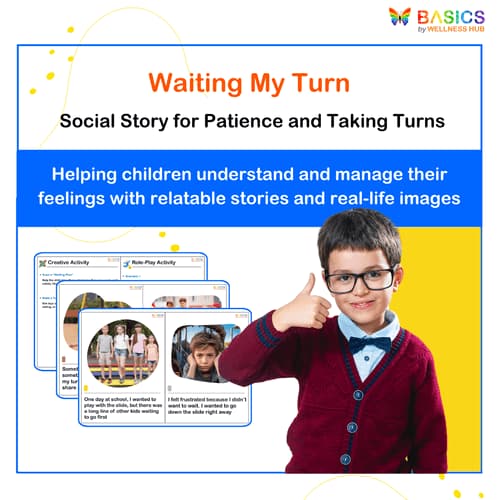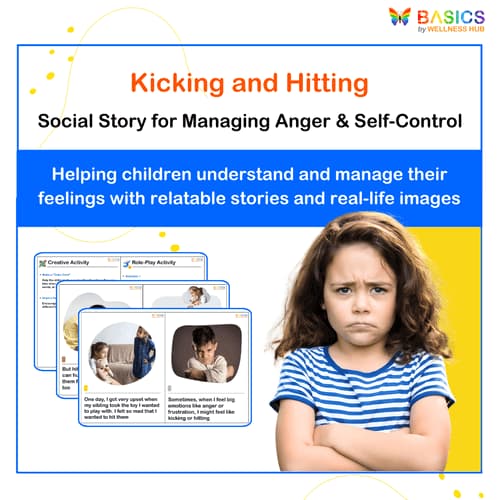





Conversation Cards - Play and Activities
₹80
₹160
50% off
0 (0 ratings)
Grade Levels
Preschool - Grade 2 (Ages 3-7)
Content Overview
Format: 1 PDF, 4 pages Total: 28 questions/statements Features: Fun, relatable prompts for kids, high-quality images.
Categories
Pages from the Resource
These conversation cards focus on playtime and activities kids love. With 28 engaging prompts, this resource encourages kids to express their thoughts and preferences while building language and social skills. Perfect for one-on-one discussions or group settings.

Page 1

Page 2
What Users Say
0
0 ratings
5
0+
4
0+
3
0+
2
0+
1
0+
5 Stars
Product is Good to use.
10 months ago
Varsha Parent
Similar Products

Understanding Impulsive Behavior: Social Story with Coping Strategies
₹ 80.00
₹ 160.00
50% off
4.9 (42 ratings)

When I Feel Like Interrupting – Social Story for Self-Control
₹ 80.00
₹ 160.00
50% off
4.8 (60 ratings)

Waiting My Turn – Social Story for Patience and Taking Turns
₹ 80.00
₹ 160.00
50% off
4.7 (56 ratings)

Kicking and Hitting – Social Story for Managing Anger & Self-Control
₹ 80.00
₹ 160.00
50% off
4.6 (52 ratings)

Understanding Swear Words – Social Story for Respectful Communication
₹ 80.00
₹ 160.00
50% off
4.9 (48 ratings)
About the Product
Conversation Cards - Play and Activities is a versatile resource designed to help young children enhance their communication, social skills, and cognitive development through engaging conversations about play and activities. These cards prompt children to think creatively, share their experiences, and express themselves in a comfortable and playful manner. They are perfect for parents, educators, and therapists who aim to encourage interactive learning while fostering essential social-emotional skills in a fun and relaxed environment.
Product Details
Format: Digital PDF
Total Pages: 4 pages
Number of Questions/Statements: 28
Content Overview: The resource consists of 28 high-quality cards featuring colorful pictures alongside engaging questions and statements. Each card is carefully crafted to prompt discussions around various play activities, indoor and outdoor games, make-believe, building, drawing, sports, and more. The cards are easy to print and can be used individually or as part of structured activities.
Educational Benefits
Language Development: These cards encourage children to articulate their thoughts, describe their favorite activities, and engage in meaningful discussions. They support vocabulary building, sentence structure development, and the ability to express emotions and ideas.
Social-Emotional Learning: By exploring topics related to play and interaction, children learn about cooperation, sharing, teamwork, and empathy. The cards provide a platform for practicing active listening, taking turns, and understanding others’ perspectives.
Cognitive Growth: The resource helps develop critical thinking skills by prompting children to reflect on their experiences and imagine new scenarios. The open-ended questions stimulate creativity, problem-solving, and the ability to make connections between different activities.
Play-Based Learning: By focusing on play and activities, the cards align with play-based learning approaches that support holistic development in early childhood. The fun and engaging topics make learning feel like a natural part of a child’s playtime.
Instructions for Use
Printing and Preparation: For best results, print the cards on thick, high-quality paper or cardstock to ensure durability. Consider laminating the cards for long-lasting use, especially in classroom or therapy settings.
Usage in Different Settings: In one-on-one conversations, the cards can be used during parent-child or educator-child interactions by picking a card, asking the question, and encouraging thoughtful responses and discussion. For group activities, children can take turns drawing a card and answering the question, promoting social interaction, turn-taking, and group engagement. Additionally, the cards can be incorporated into playtime by pairing them with related activities, such as discussing outdoor games before heading outside or talking about favorite toys during a play session.
Progressive Learning: Start with simpler questions to build the child’s confidence, then gradually introduce more complex or abstract prompts as they become more comfortable with expressing their thoughts.
Activities Using the Resource
Interactive Play Discussions: Engage children in meaningful conversations during their playtime. For example, if a child is building with blocks, use the card asking, “Do you like to build things? What do you build with?” This activity integrates language learning into the play, allowing children to express their thoughts while engaging in hands-on activities.
Themed Storytelling Sessions: Choose a few cards and have the child use them as prompts to create a story. For instance, if you pick a card like “What’s your favorite story to act out?” the child can elaborate on their favorite scenes, characters, or even act it out themselves. This activity promotes imagination, sequencing, and creative expression.
Group Conversation Circles: In a classroom or group setting, pass around the cards and encourage each child to share their answers. For example, “What game do you play with your friends?” This promotes active listening, turn-taking, and understanding different perspectives while building confidence in public speaking.
Role-Playing Games: Select cards like “Do you like to pretend? What do you pretend to be?” and have the children act out the scenarios. This activity not only enhances verbal skills but also strengthens social-emotional skills like empathy, teamwork, and cooperative play.
Outdoor Exploration and Reflection: For cards related to outdoor activities, such as “What do you see when you go on a walk?” take the activity outdoors. Let the child explore their environment and discuss what they see, hear, or feel. This merges learning with real-life experiences, reinforcing observational skills and descriptive language.
Memory and Recall Games: After discussing a few cards, hide them and ask the child to recall the questions and their responses. This strengthens memory, attention to detail, and reinforces language usage in context.
FAQs
Q1: Are these cards suitable for children with special needs?
A1: Yes, the cards are designed to be accessible for children of all abilities, including those with communication delays, Autism, or other developmental needs. The prompts are clear and can be adapted to suit the child’s level of understanding.
Q2: Can these conversation cards be used for non-verbal children?
A2: Absolutely. While the cards are designed for verbal responses, they can also be used with visual aids, gestures, or alternative communication methods like AAC devices to support non-verbal children.
Q3: How can I make the activity more challenging for advanced learners?
A3: You can encourage the child to expand on their answers by asking follow-up questions, such as “Why is that your favorite game?” or “What would you do differently?” You can also ask the child to elaborate on their answers by telling a related story or acting out the scene.
Q4: Can these cards be used in a classroom setting?
A4: Yes, they are versatile enough for both individual and group settings. Teachers can use the cards during circle time, small group activities, or as part of thematic lessons related to play and creativity.
Q5: What’s the best way to introduce the cards to a child?
A5: Start with topics that the child is familiar with, such as their favorite games or toys. This builds their confidence and encourages them to engage in more complex or imaginative questions as they grow more comfortable.
Q6: How often should I use these cards with my child?
A6: Consistency is key. Using the cards a few times a week allows for steady progress in language skills, creativity, and social-emotional development. However, the frequency can be adjusted based on the child’s interest and engagement.
Usage Rights and Restrictions
Personal Use Only: This resource is intended for personal or single-classroom use by the purchaser. It may not be reproduced, shared, or distributed for use in multiple classrooms, by multiple individuals, or for commercial purposes without purchasing additional licenses.
No Redistribution: The contents of this PDF are copyrighted and cannot be shared with others, uploaded online, or used for mass distribution without prior permission from the creator.
Digital Use: The digital file can be downloaded and printed as needed, but it may not be modified, repurposed, or resold in any form.
Conclusion
Thank you for choosing our Conversation Cards - Play and Activities resource. We hope these cards inspire countless meaningful conversations, creative stories, and joyful learning moments. By integrating language development with play, this resource offers a fun and engaging way for children to express themselves, connect with others, and build confidence in communication. We wish you and your learners happy conversations and enriching experiences ahead!



